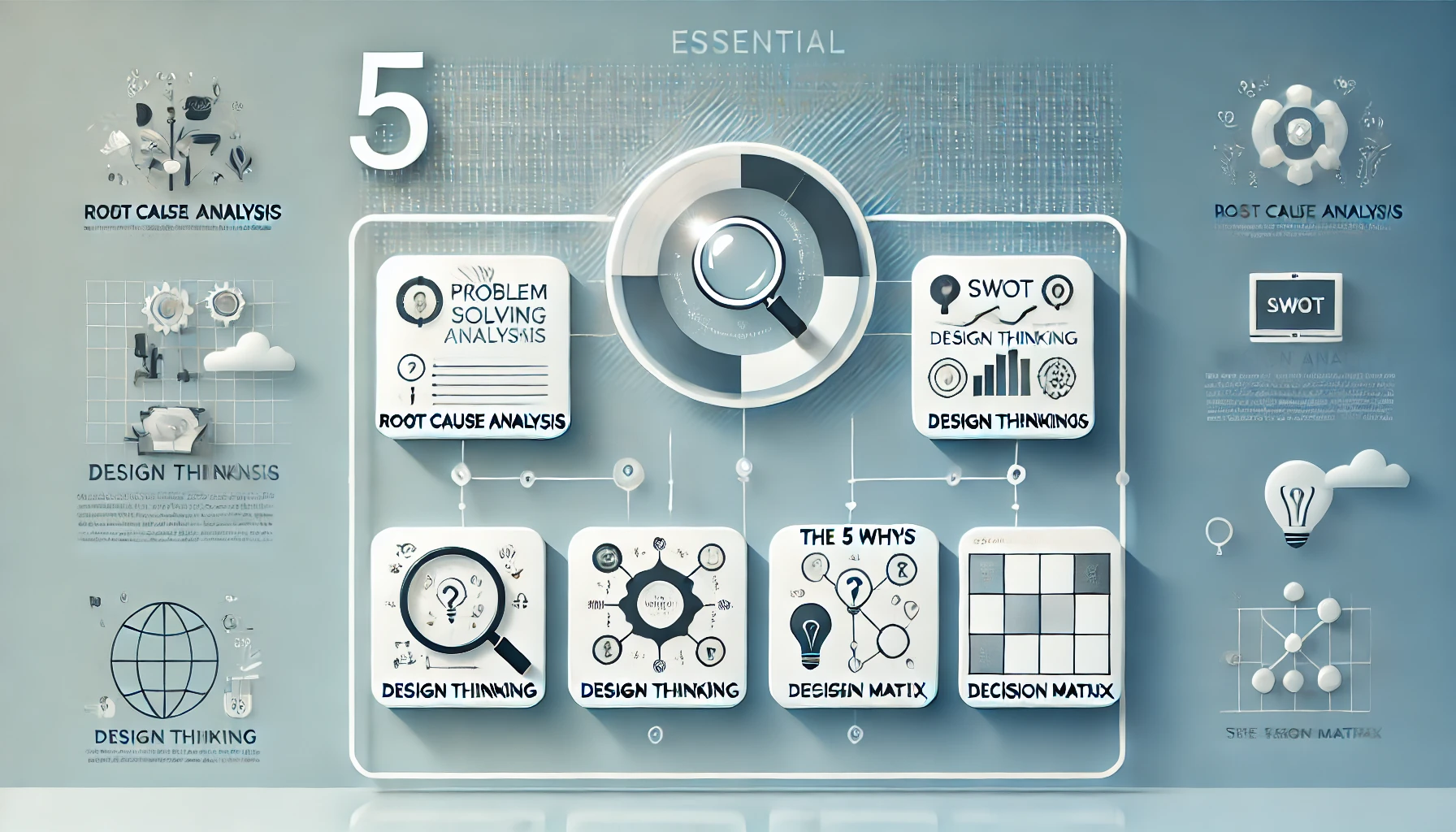🛠️ 5 Essential Problem-Solving Frameworks to Tackle Complex Issues
In both personal and professional settings, solving problems efficiently is a vital skill. From identifying root causes to communicating solutions, the right tools and frameworks can make the difference between success and failure. This guide introduces you to 5 essential problem-solving frameworks that will help you analyze complex issues, structure your thoughts, and present clear solutions.
These frameworks have been proven effective in multiple fields, including business, consulting, and engineering. Let’s dive in and explore each framework’s purpose, how to use them, and when to apply them to make informed decisions.
🎯 1. Ishikawa Diagram (Fishbone Diagram)
The Ishikawa Diagram, also known as the Fishbone Diagram, is a cause-and-effect analysis tool that helps you identify potential causes of problems. Its structure resembles a fish skeleton, with the problem (effect) at the “head” and causes branching out like “bones.”
📌 How to Use It:
Organize causes by category (e.g., manpower, methods, machines, etc.).
Construct the diagram with the main problem at the head.
Explore each cause deeply, identifying root causes for each category.
🎯 When to Use It:
Best for quality control and process improvement.
Useful in team settings for brainstorming potential causes of a problem.
Helps visualize the relationships between causes and effects clearly.
💡 Example:
You’re experiencing delays in project deliveries. Using an Ishikawa diagram, you can list potential reasons: inadequate resources, poor time management, technology failures, etc., and visually map them to investigate further.
🔍 2. Issue Trees
Issue Trees break down complex problems into smaller, more manageable elements. They help define the core issue and connect it to sub-problems, enabling a logical flow to analyze different aspects of a problem systematically.
📌 How to Use It:
Start by identifying the core issue or question.
Break down the issue into smaller sub-problems.
Connect parts logically to see how each piece contributes to the overall problem.
🎯 When to Use It:
Ideal when facing multi-faceted issues.
Use when needing a step-by-step approach to explore solutions.
Great for group analysis or individual problem-solving.
💡 Example:
In a consulting scenario, if profits are declining, an issue tree can help dissect the problem by breaking it into customer satisfaction, pricing strategy, operational inefficiencies, and market competition. From there, you can explore each root cause systematically.
🧩 3. MECE Framework
The MECE (Mutually Exclusive, Collectively Exhaustive) Framework ensures that when analyzing a problem, you cover all possibilities without overlap. This framework is crucial for breaking down information or data in a clear, structured way.
📌 How to Use It:
Group information into categories that are mutually exclusive (no overlap).
Ensure that all possible scenarios are covered (collectively exhaustive).
Use for data structuring, strategic analysis, and decision-making.
🎯 When to Use It:
Use when you need to organize information cleanly.
Ideal for research, strategy development, or ensuring thorough analysis.
Helps avoid gaps or redundancies in your thought process.
💡 Example:
You’re analyzing customer behavior to improve a product. Using MECE, you could categorize the data into “purchasing behavior,” “user demographics,” and “feedback,” ensuring each category is distinct but all-encompassing.
📊 4. Pyramid Principle
The Pyramid Principle, developed by Barbara Minto, is a structured communication technique that helps organize complex information starting from the conclusion and working backward. This is useful in both problem-solving and presenting solutions.
📌 How to Use It:
Begin with your main conclusion or key message.
Add supporting points or arguments beneath it.
Provide supporting data and evidence to back each point.
🎯 When to Use It:
Ideal for presenting complex information clearly.
Great for use in writing reports, delivering presentations, or speaking.
Best when you need to convince audiences with logic and clarity.
💡 Example:
If you’re proposing a business strategy change, you could start by stating the main conclusion (“We need to pivot our product offering”). From there, you provide supporting points, such as market trends, competitor analysis, and customer data.
📋 5. SCQA Framework
The SCQA Framework (Situation, Complication, Question, Answer) is a narrative framework that structures communication by first setting up the situation, highlighting the complication, and then asking a key question that leads to the answer or solution.
📌 How to Use It:
Define the current situation.
Highlight the complication or problem.
Ask a relevant question related to the complication.
Provide the solution or answer.
🎯 When to Use It:
Effective for pitches, proposals, or strategic narratives.
Helps engage stakeholders by presenting a clear, logical flow.
Ideal for aligning teams or persuading decision-makers.
💡 Example:
For a project delay, you might frame the situation (“We are behind schedule on our deliverables”), highlight the complication (“Key resources were unavailable”), ask the question (“How can we adjust to meet the deadline?”), and offer the solution (“By reallocating resources and prioritizing key tasks”).
⚙️ Conclusion: 5 Essential Problem-Solving Frameworks to Tackle Complex Issues
Each of these 5 essential problem-solving frameworks offers a unique approach to dissecting and addressing problems, whether in business strategy, process improvement, or communication. Understanding when and how to use each framework can significantly improve your ability to approach and resolve complex issues methodically.
Here’s a quick recap of when to use each framework:
Ishikawa Diagram (Fishbone): Best for identifying root causes in team problem-solving.
Issue Trees: Use when you need to break down complex problems logically.
MECE Framework: Ensures comprehensive and non-overlapping data analysis.
Pyramid Principle: Perfect for clear, structured communication of complex ideas.
SCQA Framework: Best for engaging narratives in pitches or proposals.
By mastering these frameworks, you can improve both your problem-solving skills and your ability to communicate solutions effectively. 🚀
























